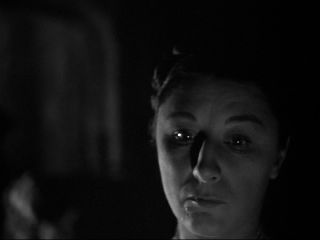The MacGuffin: News and Comment (07/Jul/2012)
(c) Ken Mogg (2012)
July 7
I begin to wonder if, seen aright, Rebecca isn't Hitchcock's finest film, so satisfying is it at many levels of achievement and insight. I have always rated it above Psycho, for instance. (Other viewers than me, probably younger ones, who rate a film mainly by its 'thesis' or its capacity to thrill or its closeness to perceived modern attitudes, including sheer iconoclasm, are free to differ, obviously.) I began last week to note and discuss some of the purely formal qualities of Rebecca. To me, these qualities are perfectly valid as givers of aesthetic satisfaction, bearing in mind that a definition by Hitchcock of 'pure film' is: 'like how notes of music make a melody'. If you can see the 'pure film' behind the individual components (the 'notes' and even individual melodies), everything else is, in a sense, secondary. Nonetheless, it strikes me that many of the formal elements in Rebecca contribute in a meaningful way to the film's general depiction of the world. They are stylised, but they aren't wholly abstract. I briefly discussed last week the stylised use of shadow-effects to give 'tone' to this very Selznick film. Another instance is the slanted bars seen shadowed on a staircase wall behind Maxim, Frank, and Colonel Julyan after the three men have attended the mortuary where Maxim identified Rebecca's body. Besides fitting the 'stylised shadows' motif generally - and thereby 'reinforcing' that motif - the image carries a vaguely 'forensic' suggestiveness (and the men's ascent of the staircase tells us that the mortuary itself is located in a basement, which is also suggestive). In turn, the bars are of course redolent of prison bars, reminding us of the possible fate awaiting Maxim after the forthcoming inquest. Now, speaking of that inquest, consider again what I described last week as 'the amorphous shadows above the row of caps on the wall behind Ben' (seen being asked for his evidence). I was wrong to write: 'There is no way of knowing what exactly the shadows represent' - they are in fact the shadows of the caps themselves, lit improbably from below (see frame-capture two weeks ago). If the effect is supposed to represent firelight, it is extremely stylised, for there is not the slightest sway or flicker. As noted last week, many of these stylised effects in Rebecca 'are designed to work "subliminally", and not to be questioned'. (And in fact a different viewpoint a moment later shows that the shadows of the caps have gone!) So why have the effect here at all? One answer: just to fill or soften an otherwise large area of wall behind Ben, while keeping up the 'stylised shadows' motif. But there's also another possible answer: the film has many shots where light suddenly comes from below, and thus this shot fits such a 'bottom-lit' motif too. In the frame-capture below, from near the end of the film, we see a mad Mrs Danvers carrying a candle through the darkened rooms of Manderley (which she is about to burn down). Also, earlier, we had suddenly seen an enraged Maxim lit from below - the light ostensibly coming from a film projector on which he is running movies of his recent honeymoon - and again there's a connotation of madness (as also with Ben). 'Anger is short madness', as the saying goes. Maxim will explain his possible madness by attributing it to 'living with the Devil' (i.e., Rebecca). So these shots all contribute to a certain pattern. In turn, there are innumerable shots (including the stylised ones of leaf-shadows on walls) reminding us of the elements of water, fire, wind, and of Nature generally, which is very much in keeping with what Hitchcock took over from Daphne du Maurier's novel. In the film's opening narration, adapted from the novel, we hear the words: 'The drive wound away in front of me ... [But] Nature had come into her own again, and, little by little, had encroached upon the drive with long, tenacious fingers.' Round about here, and elsewhere in the novel, there's a sense of an inimical force threatening civilised society. In the case of Rebecca, whom I have described elsewhere as 'a sort of female Űbermensch', she is identified by film and novel with the very sea itself (which she, an expert yachtsperson, had sought to 'master'). Rebecca looks forward to Rope (with its two would-be 'Supermen'), not to say The Birds (which Hitchcock said shows 'how catastrophe surrounds us all'). My point this week, though, has been mainly how the very texture of Rebecca acts like a subliminal reminder that every moment is part of an unfolding pattern, and fraught with difficulties and dangers. To be continued.
This material is copyright of Ken Mogg and the Hitchcock Scholars/'MacGuffin' website (home page) and is archived with the permission of the copyright holder. |

